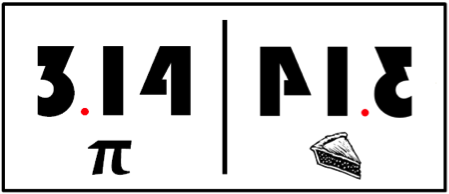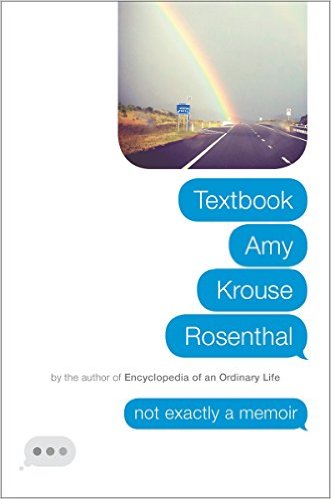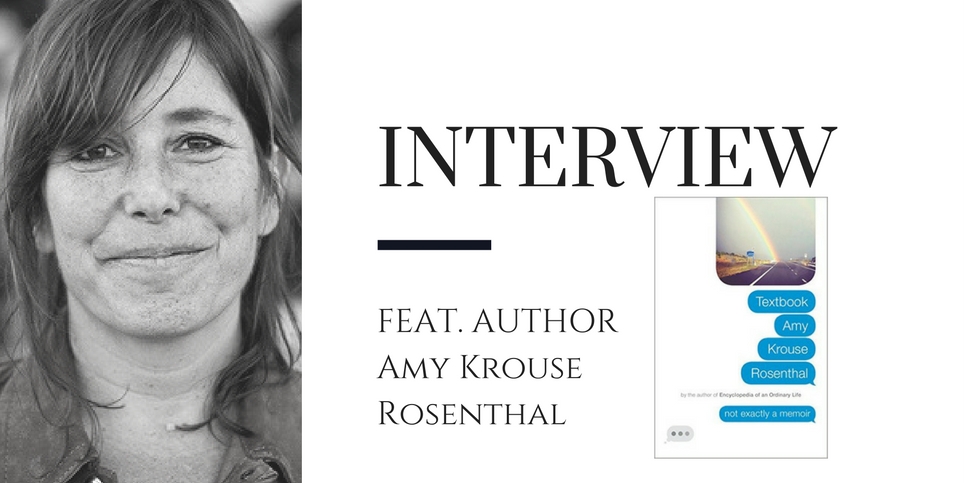Interview Provided by Marketing and Publicity at Dutton
The Children’s Book Review | August 7, 2016
Amy Krouse Rosenthal writes for both adults and children. Learn about TEXTBOOK ANY KROUSE ROSENTHAL and how writing for adults differs from writing for children.
TEXTBOOK AMY KROUSE ROSENTHAL has a unique structure for a memoir—the prose is organized into sections such as Social Studies, Music, and Language Arts. Why did you choose this format for your second book?
I gave myself the challenge of trying to find an idea that would have a logical connection to my previous book, Encyclopedia of an Ordinary Life, which was an alphabetically structured memoir. I was looking for a way to organize my material—cobbling pieces together without an anchoring device was just not an option in my mind, but the same alphabetical structure was off the table because I had no interest in making a Volume II. It took a few years and countless false starts and dead ends, but when I hit up on the idea of a “textbook,” I knew instantly that this was it.
Two of my kids were in high school at the time so we had plenty of textbooks lying around. It was actually really fun to go through them and think about how the various elements might play a role in my book, stuff like “compare/contrast” and “short answer” that were part of the review sections of every unit, and how the margins were used to point out key words and definitions. As I explored the notion of a textbook further, other exciting nuances emerged.
While the structure of TEXTBOOK AKR may be described as whimsical, the themes you present—love, loss, family, aging—are universal and meaningful. Is it a conscious effort to balance weightier material with a lighter narrative, or do you consider these two elements inextricable?
You know how one minute you’re giggling about some random silly thing and the next minute you receive dreadful news and you’re sobbing… and then a minute after that, you get the hiccups? I’m interested in a narrative—a reading experience—that reflects this. And as far as dance partners go, I think the weighty and the playful happen to be very well matched.
Many of your projects, including your previous memoir Encyclopedia of an Ordinary Life, are interactive and encourage viewer and reader engagement. You continue this trend in TEXTBOOK AKR. When and how did you start experimenting with unconventional and meaningful ways to connect with your readers?
I’ve been engaging in an interactive way with readers from my very first moment in print. I can’t even say how or why this even started—I’ve just always had a pull to create these interactions. It’s like an absolutely natural extension of not just of my writing, but of my being. I’ve come to think of it as dialoguing with the universe. The inaugural vehicle was Might Magazine, Dave Eggers’ first publication in the 90’s. I often closed my articles with some sort of dangling question and/or offering, and then, because this was pre-Internet, directed readers to my P.O. box. (!) I loved opening that little metal box and pulling out assorted envelopes from assorted strangers. When the Internet was born, I remember feeling—in addition to awe—immense gratitude that my existence intersected with this era; all my experiments with connecting people together suddenly had this phenomenally perfect tool and platform. I explored the possibilities of each new portal as they emerged—interacting via email…YouTube videos…social media. And now…texting!
Your bestselling children’s books (Little Pea, Duck!Rabbit!, Spoon, Uni the Unicorn) are extremely popular. How is writing for adults different than writing for children, or is it more similar than one might think?
I’d say they are 78% very similar and 22% very different. And in my experience, that not only applies to the writing side of things, but the other side too—the kinds of questions children and adults ask me. They are nearly identical.
In terms of the writing, at the end of the day, they both pretty much involve the same task: trying to pluck the right words to form the right sentence to muster the right narrative.
My son (who shares my love of Maria Popova’s Brain Pickings) sent me this passage from one of her recent columns:
“Anyone who writes down to children is simply wasting his time,” E.B. White observed in a wonderful 1969 interview. “You have to write up, not down.” What’s true of great children’s books is true of great science books, which must do three things for the reader — explain, enchant, and elevate.”
I just love that.
You’re also known for your viral videos The Beckoning of Lovely, The Money Tree, Life is a Marathon, and others. Are there certain things which you feel are better expressed in film than in writing? And how do you decide which format to use?
Often when I have an idea, or the seed of an idea, I’m not sure what it will “grow up” to be. Does it want to be a book? Does it want to be a video? Does it want to just be a greeting card or a poster or a guided keepsake journal? As I dive further into the idea, usually IT tells ME what it wants to be. So I try to listen to that.
And by the way, I like the term tiny filmmaker because whether you interpret that as someone who makes tiny films or someone tiny who makes films, both are correct!
What is your writing process like? Are there any specific rituals you follow or a certain time of day you prefer to write?
I love writing in the afternoon.
I love writing in coffeehouses.
I love writing in the font Playfair Display and sometimes Arial;
I think differently in different typefaces.
Here is a photo of my beloved coffeehouse in Chicago, Filter.
It is where I wrote most of Textbook AKR.

Here is a passage from the book about writing in the afternoon:
I like writing in the afternoon. The morning is the warm-up period. I can sometimes trick myself into a few sentences by standing at the counter eating a yogurt next to my laptop which just happens to be open. But for the real thing, I need to sit down, feel the day’s edges rub up against me, touch the afternoon with my left hand and impending evening with my right.
Upon publication of Encyclopedia of an Ordinary Life you sent a pie to one lucky reader, and now you’re doing it again for TEXTBOOK AKR, so we have to ask… what’s your favorite pie?
Is pie in the sky a flavor? If so, that’s for sure my favorite.
Truth be told, I’m more of a salty/savory kind of gal;
I’ve never met a bag of potato chips that I didn’t like.
One more thing about pie: I just recently learned about this visual coincidence.
How cool is this?!

What do you hope readers take away from TEXTBOOK AKR?
An experience that was impactful, beautiful, and useful.
***
 Textbook Amy Krouse Rosenthal
Textbook Amy Krouse Rosenthal
Written by Amy Krouse Rosenthal
Publisher’s Synopsis: The bestselling author of Encyclopedia an Ordinary Life returns with a literary experience that is unprecedented, unforgettable, and explosively human.
In the ten years since the publication of her beloved, groundbreaking Encyclopedia of an Ordinary Life, #1 New York Times bestselling author Amy Krouse Rosenthal has been quietly tinkering away. Using her distinct blend of nonlinear narrative, wistful reflections, and insightful wit, she has created a modest but mighty new work.
Why the title Textbook Amy Krouse Rosenthal?
• Because the book is organized into chapters with classic subject headings such as Social Studies, Music, Language Arts, Math, etc.
• Because textbook is an expression meaning “quintessential,” as in, Oh, that wordplay and unconventional format is so typical of her, so textbook Amy.
• Because for the first time ever, readers can further engage with a book via text messaging.
• Because if an author’s previous book has Encyclopedia in the title, following it up with a Textbook would be rather nice.
Not exactly a memoir, not just a collection of observations, Textbook Amy Krouse Rosenthal is an exploration into the many ways we are connected on this planet and speaks to the awe, bewilderment, and poignancy of being alive.
Adult | Publisher: Dutton | 2016 | ISBN-13: 978-1101984543
Add this book to your collection: Textbook Amy Krouse Rosenthal
Available Here:
About Amy Krouse Rosenthal
Amy Krouse Rosenthal writes for both adults and children. Her alphabetically structured memoir Encyclopedia of an Ordinary Life was named one of the top ten of the decade. She has written more than thirty children’s picture books, including Little Pea, Spoon, Exclamation Mark, Duck! Rabbit!, Uni the Unicorn, and I Wish You More. A New York Times review declared that her children’s books “radiate fun the way tulips radiate spring: they are elegant and spirit-lifting.” Amy has been a regular contributor to YouTube (The Beckoning of Lovely, The Money Tree), public radio, and TED (7 Notes on Life). She lives in Chicago.
This discussion with Amy Krouse Rosenthal about Textbook Amy Krouse Rosenthal was conducted by the publicity team at Dutton. Discover more books by Amy Krouse Rosenthal by following along with our reviews and articles tagged with Amy Krouse Rosenthal and Memoirs.

